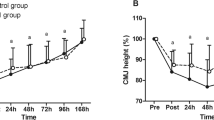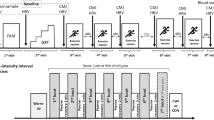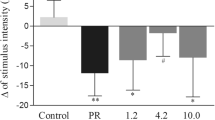Abstract
Cryotherapy and phototherapy have been suggested as recovery methods due to their anti-inflammatory effects. They may also induce mitochondrial biogenesis, thus favoring endurance training adaptation. The aim of this study was to evaluate the anti-inflammatory and ergogenic effects of phototherapy or cold water immersion (CWI) applied daily after exercise in rats. Thirty-five rats were divided into five groups: control (CO), non-exercised (CE), passive recovery (PR), cold water immersion (CWI), and LED therapy (LED). The CO and CE groups were not submitted to training; however, the CE were submitted to an exhaustion test after the training period. Low-intensity swimming training (21 sessions, 45 min) was performed followed by passive recovery (PR), CWI (10 °C, 5 min), or infrared irradiation (940 nm, 4 J/cm2). Forty-eight hours after the final training session, the CE, PR, CWI, and LED animals were submitted to an exhaustion test. The animals were euthanized 24 h later and submitted to hematological, creatine kinase (CK), and C-reactive protein (PCR) analysis. Gastrocnemius and soleus muscles were submitted to histological analysis. No differences in blood cell counts, CK, and PCR were detected between groups. The CE group presented an increased number of areas with necrosis in the gastrocnemius and soleus muscles. The PR group presented the highest frequency of areas with edema and inflammation followed by CWI and LED groups. None of the recovery methods improved the performance in the exhaustion test. Successive applications of recovery methods do not improve exercise performance, but downmodulate the inflammation and prevent muscle necrosis.

Similar content being viewed by others
References
Bangsbo J (2015) Performance in sports--with specific emphasis on the effect of intensified training. Scand J Med Sci Sports 25(Suppl 4):88–99. https://doi.org/10.1111/sms.12605
Damas F, Nosaka K, Libardi CA, Chen TC, Ugrinowitsch C (2016) Susceptibility to exercise-induced muscle damage: a cluster analysis with a large sample. Int J Sports Med 37:633–640. https://doi.org/10.1055/s-0042-100281
Peake JM, Neubauer O, Della Gatta PA, Nosaka K (2017) Muscle damage and inflammation during recovery from exercise. J Appl Physiol (1985) 122:559–570. https://doi.org/10.1152/japplphysiol.00971.2016
Howatson G, Milak A (2009) Exercise-induced muscle damage following a bout of sport specific repeated sprints. J Strength Cond Res 23:2419–2424. https://doi.org/10.1519/JSC.0b013e3181bac52e
Fredsted A, Gissel H, Madsen K, Clausen T (2007) Causes of excitation-induced muscle cell damage in isometric contractions: mechanical stress or calcium overload? Am J Phys Regul Integr Comp Phys 292:R2249–R2258. https://doi.org/10.1152/ajpregu.00415.2006
Camargo MZ, Siqueira CP, Preti MC, Nakamura FY, de Lima FM, Dias IF, Toginho Filho Dde O, Ramos Sde P (2012) Effects of light emitting diode (LED) therapy and cold water immersion therapy on exercise-induced muscle damage in rats. Lasers Med Sci 27:1051–1058. https://doi.org/10.1007/s10103-011-1039-2
Mujika I (2010) Intense training: the key to optimal performance before and during the taper. Scand J Med Sci Sports 20(Suppl 2):24–31. https://doi.org/10.1111/j.1600-0838.2010.01189.x
Chazaud B (2016) Inflammation during skeletal muscle regeneration and tissue remodeling: application to exercise-induced muscle damage management. Immunol Cell Biol 94:140–145. https://doi.org/10.1038/icb.2015.97
Ihsan M, Watson G, Abbiss CR (2016) What are the physiological mechanisms for post-exercise cold water immersion in the recovery from prolonged endurance and intermittent exercise? Sports Med 46:1095–1109. https://doi.org/10.1007/s40279-016-0483-3
da Costa Santos VB, de Paula Ramos S, Milanez VF, Correa JC, de Andrade Alves RI, Dias IF, Nakamura FY (2014) LED therapy or cryotherapy between exercise intervals in Wistar rats: anti-inflammatory and ergogenic effects. Lasers Med Sci 29:599–605. https://doi.org/10.1007/s10103-013-1371-9
Vieira A, Siqueira AF, Ferreira-Junior JB, do Carmo J, Durigan JL, Blazevich A, Bottaro M (2016) The effect of water temperature during cold-water immersion on recovery from exercise-induced muscle damage. Int J Sports Med 37:937–943. https://doi.org/10.1055/s-0042-111438
Rupp KA, Selkow NM, Parente WR, Ingersoll CD, Weltman AL, Saliba SA (2012) The effect of cold water immersion on 48-hour performance testing in collegiate soccer players. J Strength Cond Res 26:2043–2050. https://doi.org/10.1519/JSC.0b013e318239c3a1
Howatson G, Goodall S, van Someren KA (2009) The influence of cold water immersions on adaptation following a single bout of damaging exercise. Eur J Appl Physiol 105:615–621. https://doi.org/10.1007/s00421-008-0941-1
Goodall S, Howatson G (2008) The effects of multiple cold water immersions on indices of muscle damage. J Sports Sci Med 7:235–241
Lubkowska A, Dudzinska W, Bryczkowska I, Dolegowska B (2015) Body composition, lipid profile, adipokine concentration, and antioxidant capacity changes during interventions to treat overweight with exercise programme and whole-body cryostimulation. Oxidative Med Cell Longev 2015:803197. https://doi.org/10.1155/2015/803197
Ihsan M, Markworth JF, Watson G, Choo HC, Govus A, Pham T, Hickey A, Cameron-Smith D, Abbiss CR (2015) Regular postexercise cooling enhances mitochondrial biogenesis through AMPK and p38 MAPK in human skeletal muscle. Am J Phys Regul Integr Comp Phys 309:R286–R294. https://doi.org/10.1152/ajpregu.00031.2015
Joo CH, Allan R, Drust B, Close GL, Jeong TS, Bartlett JD, Mawhinney C, Louhelainen J, Morton JP, Gregson W (2016) Passive and post-exercise cold-water immersion augments PGC-1alpha and VEGF expression in human skeletal muscle. Eur J Appl Physiol 116:2315–2326. https://doi.org/10.1007/s00421-016-3480-1
Broatch JR, Petersen AC, Bishop DJ (2017) Cold-water immersion following sprint interval training does not alter endurance signaling pathways or training adaptations in human skeletal muscle. Am J Physiol Regul Integr Comp Physiol:ajpregu 313:372–384. https://doi.org/10.1152/ajpregu.00434.2016
Halson SL, Bartram J, West N, Stephens J, Argus CK, Driller MW, Sargent C, Lastella M, Hopkins WG, Martin DT (2014) Does hydrotherapy help or hinder adaptation to training in competitive cyclists? Med Sci Sports Exerc 46:1631–1639. https://doi.org/10.1249/MSS.0000000000000268
Aguiar PF, Magalhaes SM, Fonseca IA, da Costa Santos VB, de Matos MA, Peixoto MF, Nakamura FY, Crandall C, Araujo HN, Silveira LR, Rocha-Vieira E, de Castro Magalhaes F, Amorim FT (2016) Post-exercise cold water immersion does not alter high intensity interval training-induced exercise performance and Hsp72 responses, but enhances mitochondrial markers. Cell Stress Chaperones 21:793–804. https://doi.org/10.1007/s12192-016-0704-6
Farivar S, Malekshahabi T, Shiari R (2014) Biological effects of low level laser therapy. J Lasers Med Sci 5:58–62
de Freitas LF, Hamblin MR (2016) Proposed mechanisms of photobiomodulation or low-level light therapy. IEEE J Sel Top Quantum Electron 22. https://doi.org/10.1109/JSTQE.2016.2561201
Masha RT, Houreld NN, Abrahamse H (2013) Low-intensity laser irradiation at 660 nm stimulates transcription of genes involved in the electron transport chain. Photomed Laser Surg 31:47–53. https://doi.org/10.1089/pho.2012.3369
Borges LS, Cerqueira MS, dos Santos Rocha JA, Conrado LA, Machado M, Pereira R, Pinto Neto O (2014) Light-emitting diode phototherapy improves muscle recovery after a damaging exercise. Lasers Med Sci 29:1139–1144. https://doi.org/10.1007/s10103-013-1486-z
Nampo FK, Cavalheri V, Ramos Sde P, Camargo EA (2016) Effect of low-level phototherapy on delayed onset muscle soreness: a systematic review and meta-analysis. Lasers Med Sci 31:165–177. https://doi.org/10.1007/s10103-015-1832-4
Nampo FK, Cavalheri V, Dos Santos Soares F, de Paula Ramos S, Camargo EA (2016) Low-level phototherapy to improve exercise capacity and muscle performance: a systematic review and meta-analysis. Lasers Med Sci 31:1957–1970. https://doi.org/10.1007/s10103-016-1977-9
Chen CH, Wang CZ, Wang YH, Liao WT, Chen YJ, Kuo CH, Kuo HF, Hung CH (2014) Effects of low-level laser therapy on M1-related cytokine expression in monocytes via histone modification. Mediat Inflamm 2014:625048. https://doi.org/10.1155/2014/625048
Buravlev EA, Zhidkova TV, Osipov AN, Vladimirov YA (2015) Are the mitochondrial respiratory complexes blocked by NO the targets for the laser and LED therapy? Lasers Med Sci 30:173–180. https://doi.org/10.1007/s10103-014-1639-8
da Costa Santos VB, Ruiz RJ, Vettorato ED, Nakamura FY, Juliani LC, Polito MD, Siqueira CP, de Paula Ramos S (2011) Effects of chronic caffeine intake and low-intensity exercise on skeletal muscle of Wistar rats. Exp Physiol 96:1228–1238. https://doi.org/10.1113/expphysiol.2011.060483
Dawson CA, Horvath SM (1970) Swimming in small laboratory animals. Med Sci Sports 2:51–78
Carmo-Araujo EM, Dal-Pai-Silva M, Dal-Pai V, Cecchini R, Anjos Ferreira AL (2007) Ischaemia and reperfusion effects on skeletal muscle tissue: morphological and histochemical studies. Int J Exp Pathol 88:147–154. https://doi.org/10.1111/j.1365-2613.2007.00526.x
Mawhinney C, Jones H, Joo CH, Low DA, Green DJ, Gregson W (2013) Influence of cold-water immersion on limb and cutaneous blood flow after exercise. Med Sci Sports Exerc 45:2277–2285. https://doi.org/10.1249/MSS.0b013e31829d8e2e
Lu H, Zhu L, Lian L, Chen M, Shi D, Wang K (2015) PGC-1alpha regulates the expression and activity of IRF-1. IUBMB Life 67:300–305. https://doi.org/10.1002/iub.1369
Eisele PS, Furrer R, Beer M, Handschin C (2015) The PGC-1 coactivators promote an anti-inflammatory environment in skeletal muscle in vivo. Biochem Biophys Res Commun 464:692–697. https://doi.org/10.1016/j.bbrc.2015.06.166
de Freitas VH, Ramos SP, Bara-Filho MG, Freitas DG, Coimbra DR, Cecchini R, Guarnier FA, Nakamura FY (2017) Effect of cold water immersion performed on successive days on physical performance, muscle damage, and inflammatory, hormonal, and oxidative stress markers in volleyball players. J Strength Cond Res. https://doi.org/10.1519/JSC.0000000000001884
Assis L, Moretti AI, Abrahao TB, Cury V, Souza HP, Hamblin MR, Parizotto NA (2012) Low-level laser therapy (808 nm) reduces inflammatory response and oxidative stress in rat tibialis anterior muscle after cryolesion. Lasers Surg Med 44:726–735. https://doi.org/10.1002/lsm.22077
Karu TI, Pyatibrat LV, Afanasyeva NI (2005) Cellular effects of low power laser therapy can be mediated by nitric oxide. Lasers Surg Med 36:307–314. https://doi.org/10.1002/lsm.20148
Buravlev EA, Zhidkova TV, Vladimirov YA, Osipov AN (2014) Effects of low-level laser therapy on mitochondrial respiration and nitrosyl complex content. Lasers Med Sci 29:1861–1866. https://doi.org/10.1007/s10103-014-1593-5
Alves AN, Fernandes KP, Deana AM, Bussadori SK, Mesquita-Ferrari RA (2014) Effects of low-level laser therapy on skeletal muscle repair: a systematic review. Am J Phys Med Rehabil 93:1073–1085. https://doi.org/10.1097/PHM.0000000000000158
Silveira PC, da Silva LA, Pinho CA, De Souza PS, Ronsani MM, Scheffer Dda L, Pinho RA (2013) Effects of low-level laser therapy (GaAs) in an animal model of muscular damage induced by trauma. Lasers Med Sci 28:431–436. https://doi.org/10.1007/s10103-012-1075-6
Amadio EM, Serra AJ, Guaraldo SA, Silva JA Jr, Antonio EL, Silva F, Portes LA, Tucci PJ, Leal-Junior EC, de Carvalho Pde T (2015) The action of pre-exercise low-level laser therapy (LLLT) on the expression of IL-6 and TNF-alpha proteins and on the functional fitness of elderly rats subjected to aerobic training. Lasers Med Sci 30:1127–1134. https://doi.org/10.1007/s10103-015-1713-x
Fukuda TY, Tanji MM, Silva SR, Sato MN, Plapler H (2013) Infrared low-level diode laser on inflammatory process modulation in mice: pro- and anti-inflammatory cytokines. Lasers Med Sci 28:1305–1313. https://doi.org/10.1007/s10103-012-1231-z
Serafim KG, Ramos Sde P, de Lima FM, Carandina M, Ferrari O, Dias IF, Toginho Filho Dde O, Siqueira CP (2012) Effects of 940 nm light-emitting diode (led) on sciatic nerve regeneration in rats. Lasers Med Sci 27:113–119. https://doi.org/10.1007/s10103-011-0923-0
Pigatto Mitihiro D, de Paula Ramos S, Corazza Montero J, Alves Campos A, de Oliveira Toginho Filho D, Dezan Garbelini CC (2017) Effects of near-infrared LED therapy on experimental tooth replantation in rats. Dent Traumatol 33:32–37. https://doi.org/10.1111/edt.12301
Hayworth CR, Rojas JC, Padilla E, Holmes GM, Sheridan EC, Gonzalez-Lima F (2010) In vivo low-level light therapy increases cytochrome oxidase in skeletal muscle. Photochem Photobiol 86:673–680. https://doi.org/10.1111/j.1751-1097.2010.00732.x
Funding
This study was financially supported by the Coordination for the Improvement of Higher Education Personnel (CAPES), Brazil, for the purchase of laboratory reagents and for the post-graduation grant for VBCS (grant no.1085489/2013).
Author information
Authors and Affiliations
Corresponding author
Ethics declarations
Conflict of interest
The authors declare that they have no conflict of interest.
Ethical approval
All experiments were previously approved by the Ethics Committee on the Use of Animals of the Universidade Estadual de Londrina (protocol 077/2013).
Rights and permissions
About this article
Cite this article
da Costa Santos, V.B., Correa, J.C.M., Chierotti, P. et al. Cold water immersion or LED therapy after training sessions: effects on exercise-induced muscle damage and performance in rats. Lasers Med Sci 34, 991–999 (2019). https://doi.org/10.1007/s10103-018-2689-0
Received:
Accepted:
Published:
Issue Date:
DOI: https://doi.org/10.1007/s10103-018-2689-0




